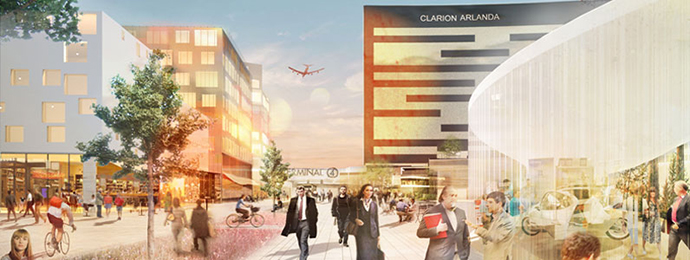Anew “unique urban design strategy” has been announced for the area surrounding Stockholm Arlanda Airport, in a bid to transform the region into “an attractive international meeting point for businesses, logistics and transportation”. Developed as part of a public-private partnership (PPP), the eco-friendly and sustainable land development plan will be known as ‘Airport City Stockholm’ and will be the first such project to be carried out in Sweden.
Stockholm is considered an ideal place to carry out such an urban strategy, not just because of its location in the heart of Scandinavia, but also because it is the region’s economic growth engine and already attracts some of the biggest industries and companies to the area.
It is not hard to see why Scandinavia, and Stockholm, offer such a pull for international businesses. Sweden, Denmark, Norway and Finland all share unique values and together form a well-knit region with well-developed infrastructure, strong cultural ties and a solid reputation among the rest of the world.
Meanwhile, Stockholm itself is Scandinavia’s largest city and is known as a dynamic centre for business, innovation, entrepreneurship and research and development in its own right.
As Olle Zetterberg, CEO of Stockholm business region, says: “Stockholm isn’t just one of the world’s most beautiful cities, but it is also the hub of Scandinavia. We have the biggest industries here, we have the economic growth engine here, and we have the biggest stock market and so forth.
“We also have a lot of cultural institutions, we have the Nobel Prize, and on top of that we are located in the middle of Scandinavia, with very good connections to the rest of the world.”
A New Hub Role for Arlanda
Sitting in Sweden’s Sigtuna kommun district, the new 800-hectare Airport City Stockholm will be developed around the country’s largest airport, Stockholm Arlanda, which today handles more than 19 million passengers a year.
It is the brainchild of a PPP comprising Swedavia – the operator of 10 of Sweden’s airports — Sigtuna municipality and Arlandastad Holding, a major real estate developer and investment company. According to the joint venture, the project will primarily focus on research and development activities, test tracks, education and conferences, restaurants, shopping and recreation.
With this new urban strategy, Airport City Stockholm eventually plans to compete with other well-established international airport cities – such as Frankfurt, Hong Kong, and Amsterdam Schiphol – by attracting start-up companies and knowledge-intensive activities. Furthermore, Airport City Stockholm’s unique vision is to become one of the most eco-friendly and sustainable airport city developments in the world, with an ultimate ambition to gain environmental certification for the whole project.
Kristina Alvendal, CEO of Airport City Stockholm, says: “Airport City Stockholm is going to be the hub of sustainability in the future. If you look at Stockholm, Sweden and Scandinavia, you can obviously see that we are in the forefront when it comes to environmental clean-tech areas.
“Regarding Stockholm Arlanda Airport, they have made tremendous environmental efforts, [some would say] world-leading,” she relates. “Stockholm was appointed the first ‘Green Capital of Europe’ and that also gives us a great ground to stand on.”
Currently 20,000 people work in the Airport City area, but this is expected to increase to 50,000 within the next decade.
Six-Node Development
The development will be split into six different areas. These include Sky City; Park City; DriveLAB Stockholm; Märsta Business Area; Cargo City and Rosersberg Logistics.
Sky City is essentially the airport city’s ‘Downtown’ district. It comprises a dense city centre, made up of a mixture of offices and hotels, and pedestrian-friendly streets and parks.
The Park City area is located at the airport entrance and includes facilities such as long-term parking, car rental firms and car services.
DriveLAB Stockholm, by the E4 highway, is a hub for training and development in road safety and green transport technologies. According to Airport City Stockholm, here companies, researchers and government agencies will have the opportunity to learn from each other and develop the automotive industry of tomorrow.
Meanwhile, the Märsta Business Area will include a diverse range of companies and industries ranging from logistics and cargo to retail, light industries, construction and crafts.
Cargo City is to the southwest of the development, with direct connections to the airport. The district is primarily used for cargo and logistics.
Finally, Rosersbergs Logistics is located directly by the E4 between Stockholm, Uppsala and the airport, and its cargo terminal has been developed into a logistic node for both large and small companies.
There are a number of companies already located in these various districts, in fact more than 250 companies have already found their way to Airport City Stockholm. These include Delta Air Lines, Skandinaviska Enskilda banken, Forex Bank, JCDecaux Sverige, Radisson Blue Sky City Hotel, SITA Group Arlanda Airport, SAS Spirit, DHL, UPS, FedEx, Baxter Medical, Ingram Micro and John Deere among others.
Meanwhile, the new Clarion Hotel Arlanda Airport opened at the gateway in November last year, and construction has also started on Office One, a building in the Sky City area, which consists of several structures and will have total office space of about 20,000 sq. m.
Airport City Stockholm is due to be unveiled in greater detail at this year’s Airport Cities World Conference and Exhibition (ACE), April 24-26, in Ekurhuleni, South Africa.
Dominic Welling is editor of globalairportcities.com
